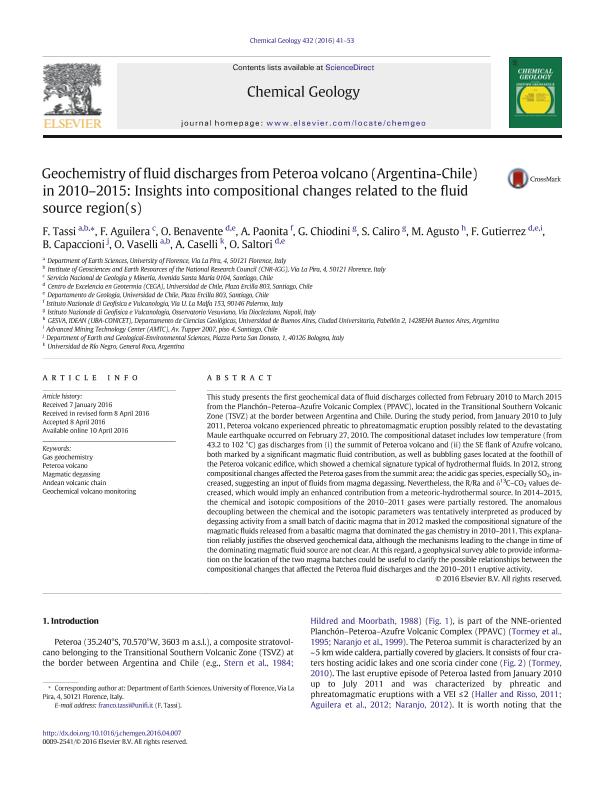Mostrar el registro sencillo del ítem
dc.contributor.author
Tassi, Franco

dc.contributor.author
Aguilera, F.
dc.contributor.author
Benavente, O.
dc.contributor.author
Paonita, A.
dc.contributor.author
Chiodini, Giovanni

dc.contributor.author
Caliro, S.
dc.contributor.author
Agusto, Mariano Roberto

dc.contributor.author
Gutierrez, F.
dc.contributor.author
Capaccioni, B.
dc.contributor.author
Vaselli, O.
dc.contributor.author
Caselli, Alberto Tomás

dc.contributor.author
Saltori, O.
dc.date.available
2017-07-27T19:46:01Z
dc.date.issued
2016-04
dc.identifier.citation
Tassi, Franco; Aguilera, F.; Benavente, O.; Paonita, A.; Chiodini, Giovanni; et al.; Geochemistry of fluid discharges from Peteroa volcano (Argentina-Chile) in 2010-2015: Insights into compositional changes related to the fluid source region(s); Elsevier Science; Chemical Geology; 432; 4-2016; 41-53
dc.identifier.issn
0009-2541
dc.identifier.uri
http://hdl.handle.net/11336/21490
dc.description.abstract
This study presents the first geochemical data of fluid discharges collected from February 2010 to March 2015 from the Planchón–Peteroa–Azufre Volcanic Complex (PPAVC), located in the Transitional Southern Volcanic Zone (TSVZ) at the border between Argentina and Chile. During the study period, from January 2010 to July 2011, Peteroa volcano experienced phreatic to phreatomagmatic eruption possibly related to the devastating Maule earthquake occurred on February 27, 2010. The compositional dataset includes low temperature (from 43.2 to 102 °C) gas discharges from (i) the summit of Peteroa volcano and (ii) the SE flank of Azufre volcano, both marked by a significant magmatic fluid contribution, as well as bubbling gases located at the foothill of the Peteroa volcanic edifice, which showed a chemical signature typical of hydrothermal fluids. In 2012, strong compositional changes affected the Peteroa gases from the summit area: the acidic gas species, especially SO2, increased, suggesting an input of fluids from magma degassing. Nevertheless, the R/Ra and δ13C–CO2 values decreased, which would imply an enhanced contribution from a meteoric-hydrothermal source. In 2014–2015, the chemical and isotopic compositions of the 2010–2011 gases were partially restored. The anomalous decoupling between the chemical and the isotopic parameters was tentatively interpreted as produced by degassing activity from a small batch of dacitic magma that in 2012 masked the compositional signature of the magmatic fluids released from a basaltic magma that dominated the gas chemistry in 2010–2011. This explanation reliably justifies the observed geochemical data, although the mechanisms leading to the change in time of the dominating magmatic fluid source are not clear. At this regard, a geophysical survey able to provide information on the location of the two magma batches could be useful to clarify the possible relationships between the compositional changes that affected the Peteroa fluid discharges and the 2010–2011 eruptive activity.
dc.format
application/pdf
dc.language.iso
eng
dc.publisher
Elsevier Science

dc.rights
info:eu-repo/semantics/openAccess
dc.rights.uri
https://creativecommons.org/licenses/by-nc-nd/2.5/ar/
dc.subject
Gas
dc.subject
Geochemistry
dc.subject
Peteroa
dc.subject
Volcano
dc.subject.classification
Vulcanología

dc.subject.classification
Ciencias de la Tierra y relacionadas con el Medio Ambiente

dc.subject.classification
CIENCIAS NATURALES Y EXACTAS

dc.title
Geochemistry of fluid discharges from Peteroa volcano (Argentina-Chile) in 2010-2015: Insights into compositional changes related to the fluid source region(s)
dc.type
info:eu-repo/semantics/article
dc.type
info:ar-repo/semantics/artículo
dc.type
info:eu-repo/semantics/publishedVersion
dc.date.updated
2017-07-13T18:16:28Z
dc.journal.volume
432
dc.journal.pagination
41-53
dc.journal.pais
Países Bajos

dc.journal.ciudad
Amsterdam
dc.description.fil
Fil: Tassi, Franco. Universita Degli Studi Di Firenze; Italia
dc.description.fil
Fil: Aguilera, F.. Servicio Nacional de Geología y Minería; Chile
dc.description.fil
Fil: Benavente, O.. Universidad de Chile; Chile
dc.description.fil
Fil: Paonita, A.. Istituto Nazionale Di Geofisica E Vulcanologia; Italia
dc.description.fil
Fil: Chiodini, Giovanni. Istituto Nazionale Di Geofisica E Vulcanologia; Italia
dc.description.fil
Fil: Caliro, S.. Istituto Nazionale Di Geofisica E Vulcanologia; Italia
dc.description.fil
Fil: Agusto, Mariano Roberto. Consejo Nacional de Investigaciones Científicas y Técnicas. Oficina de Coordinación Administrativa Ciudad Universitaria. Instituto de Estudios Andinos "Don Pablo Groeber". Universidad de Buenos Aires. Facultad de Ciencias Exactas y Naturales. Instituto de Estudios Andinos "Don Pablo Groeber"; Argentina
dc.description.fil
Fil: Gutierrez, F.. Universidad de Chile; Chile. Advanced Mining Technology Center; Chile
dc.description.fil
Fil: Capaccioni, B.. Department of Earth and Geological -Environmental Science; Italia
dc.description.fil
Fil: Vaselli, O.. Universita Degli Studi Di Firenze; Italia
dc.description.fil
Fil: Caselli, Alberto Tomás. Universidad Nacional de Rio Negro; Argentina. Consejo Nacional de Investigaciones Científicas y Técnicas; Argentina
dc.description.fil
Fil: Saltori, O.. Universidad de Chile; Chile
dc.journal.title
Chemical Geology

dc.relation.alternativeid
info:eu-repo/semantics/altIdentifier/doi/http://dx.doi.org/10.1016/j.chemgeo.2016.04.007
dc.relation.alternativeid
info:eu-repo/semantics/altIdentifier/url/http://www.sciencedirect.com/science/article/pii/S0009254116301826
Archivos asociados
